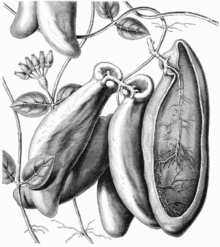Dischidia major
| Dischidia major | |
|---|---|
_Merr.00.jpg) | |
| Plate 142 from Plantae Asiaticae Rariores | |
| Scientific classification | |
| Kingdom: | Plantae |
| (unranked): | Angiosperms |
| (unranked): | Eudicots |
| (unranked): | Asterids |
| Order: | Gentianales |
| Family: | Apocynaceae |
| Subfamily: | Asclepiadoideae |
| Genus: | Dischidia |
| Species: | D. major |
| Binomial name | |
| Dischidia major (Vahl) Merr. | |
| Wikimedia Commons has media related to Dischidia major. |
Dischidia major, the Malayan urn vine, is an unusual plant. Dischidia is a genus of some 80 species of trailing, twining or scandent, succulent epiphytes found throughout the tropics of Asia (New Guinea, Moluccas, Philippines, India, tropical Australia, Hong Kong, Taiwan) through to the western Pacific. They carry modified leaves, offering accommodation to ants, including those of the family Dolichoderinae, and in return gain some sustenance from increased carbon dioxide and nitrogen levels, and a degree of protection from noxious animals and plants.[1] This mutualism trait, known as myrmecophily, is widespread across the plant world and clearly carries considerable benefits for both ants and plant.[2]
Dischidia major twines around the branches and trunks of trees, having a preference for those that are decaying. It produces both circular succulent leaves of about 2 cm diameter, and hollow, pouch-like 12 cm long leaves, reminiscent of the fruits of Araujia sericifera, a related species. These modified leaves, pitchers or ascidia, are purplish and richly dotted with stomata on the inner surface,[3] and have an opening at the top end near the stalk. Organic debris and rainwater, possibly augmented by secreted fluids, accumulate in the cavity over the course of time, offering a source of nutrition which the plant utilises by growing roots into the chamber. Dischidia astephana and D. parvifolia do not provide housing for resident ants, but have roots that penetrate decaying wood and humus, reaching into the ant nests and presumably obtaining nutrients from the ant waste there.[4][5]
Dischidia major flowers are yellow striped with green, and arranged in few or many-flowered umbels. The fruit of D. major consists of the usual horn-shaped pair of follicles while the seed has a tuft of silky hairs at one end and includes an edible portion or elaiosome as incentive for ants to move the seed (myrmecochory) into nests inside the tree with an improved chance of germination and growth.
_Merr.08a.jpg) Plate from Richard Wettstein's Handbuch der Systematischen Botanik 1924
Plate from Richard Wettstein's Handbuch der Systematischen Botanik 1924_(17813702993).jpg) Plate from Smithsonian Institution report, 1896
Plate from Smithsonian Institution report, 1896 Plate from Anton Joseph Kerner von Marilaun, Adolf Hansen: Pflanzenleben
Plate from Anton Joseph Kerner von Marilaun, Adolf Hansen: Pflanzenleben
Bibliography
- The Ecology and Evolution of Ant-Plant Interactions - Victor Rico-Gray & Paulo S. Oliveira (University of Chicago Press, 2007)
External links
- Gallery of Dischidia species
- Dischidia major
- Philidris sp. and Dischidia major
- Philidris ants living inside Dischidia epiphytes from Thailand
References
- ↑ Absorption of Ant-provided Carbon dioxide and Nitrogen by a Tropical Epiphyte
- ↑ Groom, P. (1893), "On Dischidia rafflesiana (Wall.)", Annals of Botany, os–7 (2): 223–241, doi:10.1093/aob/os-7.2.223
- ↑ On the Structure of the Ascidia and Stomata of Dischidia rafflesiana Wall.
- ↑ A reassessment of the relations in Malaysia between ants (Crematogaster) on trees (Leptospermum and Dacrydium) and epiphytes of the genus Dischidia
- ↑ Structure of the Ascidia